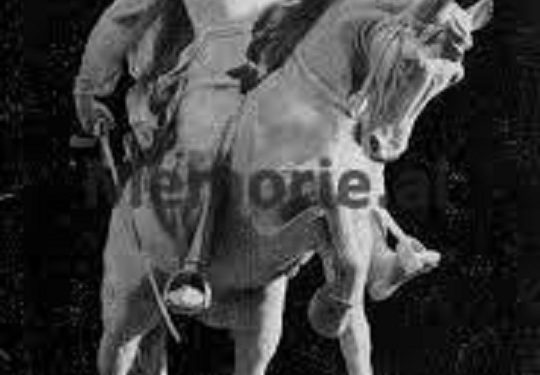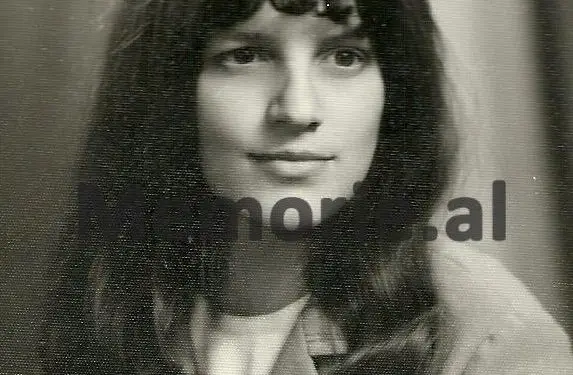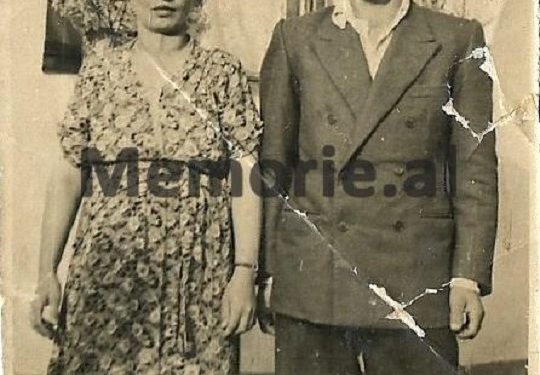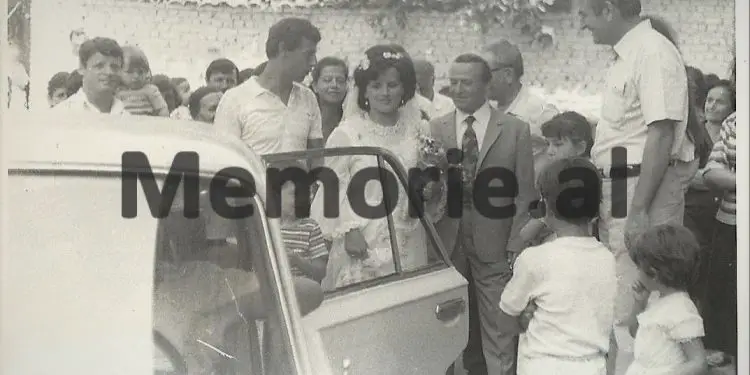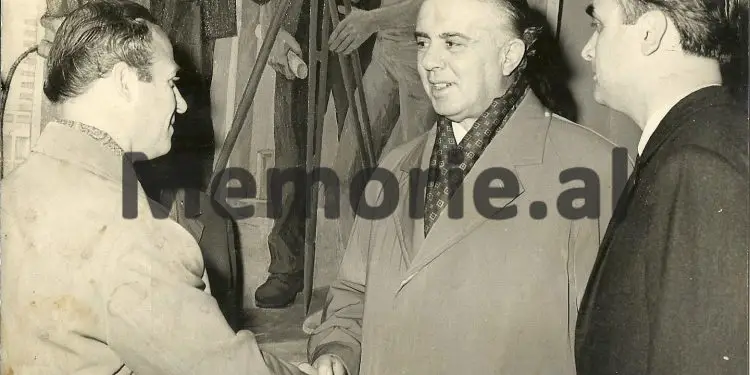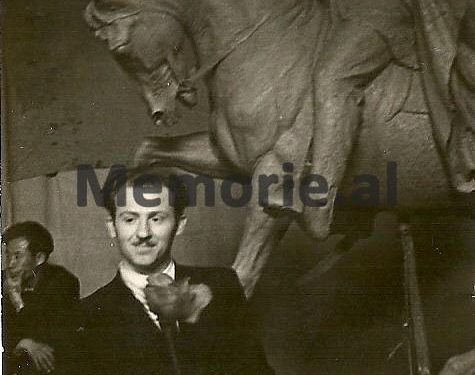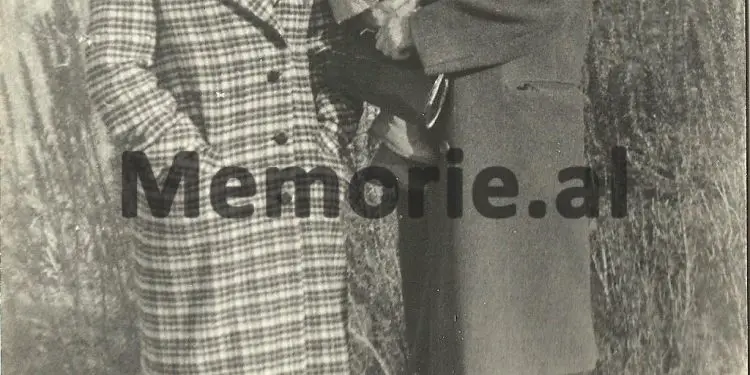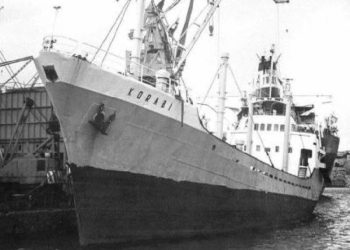Dashnor Kaloçi
Memorie.al publishes the unknown story of Thanas Papa, originally from the village of Paftal in Berat, who after graduating from the Art High School “Jordan Misja” in Tirana in 1952, won a state scholarship and attended higher studies at the “Rjepin” Institute of the Academy of Fine Arts of Leningrad, where at that time some of his other compatriots were studying, such as: Jakup Keraj, Shaban Hadëri, Kristaq Rama, Sali Shijaku, etc., where some of them he took as his assistant, during the work he did at the Institute for the Restoration and Protection of Cultural Monuments of the Soviet Union. Rare testimonies of Thanas Papa, from the graduation with ‘Gold Medal’ with “Skanderbeg on horseback” which in that academy had not happened for ten years and the evaluation by the chairman of the commission for the evaluation of student diplomas at the Institute ” Rjepin”, the famous Russian sculptor, Tomsky, so that the work could be cast in bronze and printed as a postcard. Thanas’s return to Albania where, by order from “above”, he realized some of the busts of the main leaders, such as Nikita Hurshov, Enver Hoxha, Mehmet Shehu, etc., as well as his life full of vicissitudes after being pursued by the State Security to was arrested after divorcing his Russian wife, Valentina, (who in 1961 was forced to return to the Soviet Union with his two-year-old daughter) and escaping from prison by the protection given to him by the Minister of Internal Affairs, Kadri Hazbiu, who listened to labe songs in his house, with the tape recorder that Thanas had brought from Leningrad!
“My conversation with Mehmet Shehu lasted about two hours and while I was working to give the previous shine to the bronze bust I had been working on since 1960, he kept me talking. In the end, after I had cleaned the bust, he said to me: “Ore, this is different” and thanked me, saying: “From the bottom of my heart I thank you for this beautiful gift you gave me.” When I said to him, ‘Plant,’ he replied, ‘Leave, leave, I know. At the end when we were parting, Mehmeti told me: “Sometimes we leave the house, do not forget us”. This is how the famous sculptor Thanas Papa (“Merited Artist”) remembers that meeting with the former Prime Minister Mehmet Shehu, in his villa in the “Block” of leadership, where he had gone with his request to see the bust which I had realized a few years ago.
But who is Thanas Papa and what is his past? Where did he graduate and why was Thanasi appointed to realize the bust of Prime Minister Mehmet Shehu at that time? What were the vicissitudes that followed Thanas Pope until the late 1980s and who was the man who protected him from ending up behind bars, like some of his colleagues and friends who had graduated from the former countries? Communist East in the ’50s?! Regarding this and full of other facts and events from his life, 90-year-old Thanas Papa himself knows us, through this interview given exclusively for Memorie.al.
Mr. Thanas, in short, what is the origin of your family and where were you first educated?
I was born in 1931 in the village of Paftal in Berat, where my family comes from. After graduating from the Unique School in the city of Berat in 1947, I won a state scholarship to attend the Artistic High School “Jordan Misja” in Tirana, which I graduated with excellent results. In a class with me at that time were also: Dhimitër Buda, Jorgji Gjinari, Kristaq Rama, Jakup Keraj, Shaban Hadëri, Gjinovefa Heba, Kujtim Spahivogli, etc.
What about after graduating from high school, where did you study?
After graduating from high school, my drawing teacher, Dhimitër Çani, insisted that I continue my higher studies, because according to him I had a lot of talent. So, after graduation, me and Jakup Keraj from the city of Shkodra, were awarded a state scholarship to continue higher university studies at the Institute “Rjepin” of Fine Arts in Leningrad, which I also finished with high results, receiving the “Gold Medal”.
How long did your studies last at that institute?
At that institute I studied for six years and when it came to graduation work, I chose to do Skanderbeg on horseback. After presenting the draft diploma, the famous Russian sculptor who was also the vice-president of the Academy and also the Chairman of the Diploma Evaluation Commission, said: “What Thanasi wants to do is beyond the reach of a student.” But I insisted that I would accomplish that, and for almost a year I completed my degree work, working 12 to 14 hours a day.
How was your work evaluated when the defense of diplomas was done?
When the defense of diplomas was done at our institute, the chairman of the diploma evaluation commission, the famous Russian sculptor, Tomskij (who had made the Skanderbeg monument in Tirana) gave the maximum appreciation to me. The commission also praised my work as an excellent diploma, awarding me the “Gold Medal”, together with the Russian student, Yevgeny Nikolajevic, which had not happened at that Academy for ten years. After these maximum evaluations that were given to me, the commission decided that my diploma work, ie “Skanderbeg on horseback” be poured in bronze and it was exhibited in the general exhibition of the Soviet Union for the countries of Eastern Europe, making the postcard as well…
During that time, you studied at that institute, did you have the opportunity to work outside the school walls in that profession?
During those years, the Institute for the Restoration and Protection of Monuments of the Soviet Union, which collaborated with the school where I studied, activated me in some work for the restoration of sculptures that were located in public places located somewhere on the outskirts of Leningrad. For the realization of those works, I received as assistants, my compatriots, Shaban Hadër, Kristaq Rama and Sali Shijaku, whom I paid regularly based on the work they did, because for their restoration I received a salary that was very satisfactory for a student. During those years, I received another degree in “Restoration and Protection of Cultural Monuments”.
What was the first job you did in Albania after returning from the Soviet Union?
The first work I did after returning from the Soviet Union was the bust of the “People’s Hero”, Musa Fratari, and after that, the bust of Nikita Hurshov, which was commissioned to be placed in one of the halls of the Hydropower Plant. Karl Marks” on the river Mat. Along with Khrushchev’s bust, that of Enver Hoxha was also ordered and Shaban Haderi and I were in charge of their realization. It occurred to me to do Khrushchev, as Shabani himself asked to do Enver Hoxha. After we did them, both of our works were very well received and after we poured them in bronze, they were placed in the designated place near the Karl Marks Hydropower Plant on the Mat River.
But after the breakdown of relations with the Soviet Union, what happened to the Khurshov bust that you had made?
I broke the copy of Hurshov’s bust that I had kept in my studio, after the insistence of my friend and colleague, the famous painter Guri Madhi, who when he saw it, said to me: “Thanas, break it quickly because you will take us by the neck”. As for the original that was placed in the hydropower plant “Karl Marks”, I never learned the truth about what happened to it, as I did not dare to ask anyone!
Throughout your career as a sculptor, have you had other instances where you have made figures of politicians and leaders who were later declared “enemies” and had to be broken?
Yes, he shot me with the bust of former Prime Minister Mehmet Shehu, but unlike Hurshov, the copy of Mehmet Shehu’s bust that I kept in the studio, I did not break it, but I hid it and kept it unharmed, until after years’ 90s. As he looks at it (shows us in the studio), he is still in good condition.
How did you get the idea to realize the bust of Mehmet Shehu?
The bust of Mehmet Shehu was requested by Hajredin Çeliku, the former Director of the Enver Plant, who wanted to present it to the Prime Minister in 1960, on the occasion of his birthday.
But why do I ask Hajredin Çeliku for that message?
At that time, after hearing about Hurshov’s bust that I had made from Andon Kuqali’s article in the newspaper “Drita”, Hajredini came to my studio together with the secretary of the basic organization of the “Enver” factory party and made me the request.
How did you act after that request?
After that, I immediately called Fiqret Shehu, the Prime Minister’s wife, and after telling her about the message they had given me, I told her that if possible, she should provide me with some photos of Comrade Mehmet, during the period he had been in the Spanish War.
How did she respond, was she ready?
Fiqret, with whom I knew very well, told me that he would notify me on the phone, after talking to Mehmet.
Under what circumstances did you meet the wife of Prime Minister Mehmet Shehu?
I have known Fiqret since 1958-’59, when I made a custom sculpture of the Executive Committee of Tirana, which would be placed in the “Rinia” Park in the center of the capital, opposite the “Dajti” Hotel. After I finished the sculpture (posed by two high school girls who are very popular musicians today), it was not approved by the artistic commission, which called it a “formalist work”. After that, I went to Fiqreti who was then the secretary of the Party Committee for Tirana and explained the whole problem. After listening to me attentively, she told me that she would set up another commission headed by Baki Kongoli and kept her word.
Did the commission headed by Baki Kongoli approve your work?
The commission that was created approved my work in sculpture which was placed in the Park “Youth” and in addition to this intervention of my friend Fiqret, who put in place an injustice that was being done to me, she had done me another good deed in in 1958, when she went to the Tirana Executive Committee herself and asked for two houses, one for me and one for Vasil Naçon.
Going back to your phone conversation with Fiqret about the photos they needed for Mehmet’s bust?
Fiqretja called me after talking to Mehmet, and when she told him about my request, he replied: “I know why they love them, but I do not give them the photos because they spoil them for me. I remember them. If they want you, take Ladin (the eldest son), because he looks like me for the period they are looking for.
Did Lady come to pose?
It was coming immediately and for two weeks in a row I worked on the portrait of Mehmet, Ladi who was a high school student at the time stood for 1 to 2 hours without moving to my studio. After I finished the bust in the mud, I called Fiqireta and told her to come and see her and she said: “I trusted you with that, you have Lad and I do not think that I need to come there”. After that I called Petro Marko in the studio, who came with his wife and said: “Did Mehmeti pose for you?” He liked the work I had done and spoke very well about him. Then I called Hajredin Çelik who he saw me and told me to pour it quickly in bronze, making the “Enver” Plant available to me for everything I needed.
Did they send the bust to Mehmet Shehu, and how did he receive that gift?
Hajredin Çeliku sent him the gift on the occasion of his birthday and as Foto Stamo told me, Mehmeti liked it very much and whoever went to his house, he would take it to the corridor where he had placed the bust and said: “This is how I was in Spain “.
What about the Shehu family, did they call you to thank you?
Fiqiretja took me and said: “Thanas, you surprised us all, and in particular Mehmeti liked it very much”. Likewise, when I met Fiqireten by chance once, she told me that Mehmeti had regretted not giving me the pictures.
Do you pay for Mehmet’s bust?
As a rule, payment was made by the customer, ie by the “Enver” Factory. She gave me 20,000 old lekë.
After you made the bust, did you have the opportunity to meet Mehmet Shehu in person?
Around 1968, at the “Dinamo” factory, I met his second son, Skënder, and asked him if the bust I had made still retained its luster. He told me he did not understand these things and invited me home to see for myself. After that I called Fiqireten and she told me: “come home”.
Did you go to his house?
I went immediately and surprisingly, no one stopped me until their villa. But then I learned that this was ordered by Fiqretja, who went out to the outer gate by herself and accompanied me up to where Mehmet’s bust was in the corridor. After a while, Mehmeti himself came there, who, after hugging me warmly, asked me about my family, my job, and if I had any problems, I should tell him everything. Fiqretja left after renting to us, and I was left alone with Mehmet. The conversation lasted about two hours, and as I worked to brighten up his bronze bust, Mehmet kept chatting with me. Finally, when I cleaned the bust from oxidation. Mehmeti said: “Ore… but this is different” and thanked me, saying: “Thank you from the bottom of my heart for this beautiful gift you gave me.” When I said ‘plant’, he said, ‘Leave it, leave it, I know.’ After I came out, he said to me, “Do we ever leave the house, do not forget us.”
Did you have vicissitudes afterwards, and did you seek Mehmet’s help, as he ordered?
The problems and vicissitudes did not separate me until the end of the ’80s and all this came to me as a result of my marriage to the Russian citizen, Valentina Cvetkova, with whom we separated at the end of 1961. After that separation, I was seen with a different eye from the communist regime and I was under full surveillance. I well remember March 1962, shortly after my ex-wife, Valentina, and her little 2-year-old daughter left for the Soviet Union when Guri Madhi came to my studio. He had also brought a bottle of wine and after opening it with my old shirt, he forced me to drink, while he himself did not drink at all. When I asked him why he did not drink, he replied, “I will drink too, but I gave it to you in the beginning to set you free. Keep what I am telling you. From now on, you you do not hear, you do not see, you do not speak. So, you are deaf, blind, and dumb. You have fled this world, have you heard me? The stone told me to hold my lips with my hand and squeeze it tightly. When I told him that I was in pain, he replied, “Better to have your lips hurt than your head.” Then he took the bottle of wine that had been halved by me and said, “I left the wine for last and I wanted to I was sober when I said those words to you. Don’t ask me about it anymore “and turned the wine over. It was not difficult to understand the words that Guri, who was one of my best friends, said to me. He came to me to tell me to shut up after I was targeted to be arrested by the State Security and imprisoned. Guri knew this well, as one of his brothers Stavri, was the Director of State Security in the Directorate of Tirana, while the other brother Raqi, was in the Institute of Marxist-Leninist Studies.
In that situation you were in, did you ever try to go to Mehmet Shehu, as he himself had told them?
Although I was in that situation, I never went to seek the help of Mehmet Shehu, because, by chance, I had the help of the Minister of Interior, Kadri Hazbiu.
Why were you attacked and under what circumstances did you secure the protection of Kadri Hazbi?
As I said above, the attacks on me came about the fact that I had been married to a Russian citizen and that I had a two-year-old child with her. So, since 1961, those who attacked me have reminded me of the fact that I was not getting married to start a new family, as I had in mind the ex-wife who was with her daughter in the Soviet Union. In 1967, when the Open Letter of the Central Committee of the ALP came out, I was called to the League of Writers and Artists, and told that I would be expelled from Tirana.
What happened after that?
Fortunately, I was able to escape without leaving Tirana, after the intervention of the Minister of Internal Affairs, Kadri Hazbiu, because his brother Hasan, I had neighbors and we got along very well. Hasan also did his son’s wedding at my house, where Kadriu came to listen to lab songs on the gramophone I had brought from the Soviet Union. During a conversation at Hasan’s house, he said to me: “Thanas, do not worry, whatever they say about you, the letters for signature will come to me” and pretended to tear up the letters.
But after what Kadri Hazbiu told them, did the attacks on you continue?
Although I had the protection of Kadri Hazbiu, the attacks on me did not stop until the mid-80s when I married the architect Shpresa Leka, with whom I found unstinting support for my creative work. At that time, to dedicate myself to my family, I asked for a three-year creative permit to work on the monument to Enver Hoxha on horseback at the Përmet Congress. When I finished it, he came and saw his daughter Spring, who worked as an architect with my wife Hope. She liked him very much and said that the monument was very special, as it did not resemble any other. Although that monument was exhibited with the intervention of Ramiz Alia, I was never given creative permission until I retired in 1990.
What did you do with the bust of Mehmet Shehu, after his elimination in 1981?
A few months after that event, Guri Madhi came to my studio and said to me: “Thanas, take it off because you will take us by the neck”. When I objected, he insisted by saying to me: “Ore, do you have it in your head or not, take it away I tell you”?! But in the face of my opposition, he told me not to break it, but to hide it somewhere and take it out when the time came. After Guri insisted, I wrapped the bust in some old clothes and put it in a wooden foundry box, to take it to the bottom of the warehouse, without telling the man, where I could hardly find it. This is how I kept the bust of Mehmet Shehu until the beginning of the ’90s to bring it back to light after the prophecy of Guri Madhi. I took some pictures of that bust and took it to Bashkim Shehu in the hope that I could find his original copy. But I do not know what has been done with it. /Memorie.al




